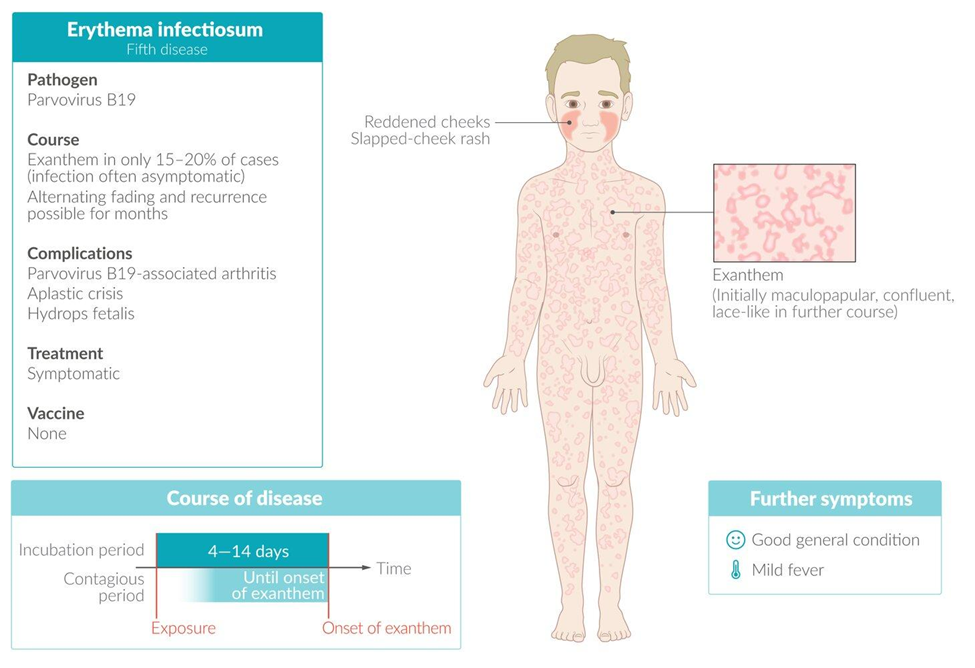On assessment, the school nurse notes that the child has a rash. The nurse suspects that the child has erythema infectiosum (fifth disease). because the skin assessment revealed a rash that has which characteristics?
A highly pruritic profuse macule to papule rash on the trunk
A discrete pinkish red maculopapular rash that is spreading to the trunk
An erythema on the face that has a "slapped face appearance
A discrete rose-pink maculopapular rash on the trunk
The Correct Answer is C
A. A highly pruritic profuse macule to papule rash on the trunk
Explanation: This description does not fit the typical characteristics of erythema infectiosum. Fifth disease is not typically associated with a highly pruritic rash.
B. A discrete pinkish red maculopapular rash that is spreading to the trunk
Explanation: While erythema infectiosum does involve a rash that can spread to the trunk, the distinctive "slapped face" appearance is a key characteristic that is not captured in this option.
C. An erythema on the face that has a "slapped face" appearance.
Explanation:
Erythema infectiosum, commonly known as fifth disease or slapped cheek syndrome, is characterized by a distinctive facial rash that gives the appearance of a "slapped face." The rash typically starts on the face and then spreads to the trunk and extremities. It often begins with erythema on the cheeks, giving the child a flushed or slapped appearance, followed by a discrete rose-pink maculopapular rash on the trunk.
D. A discrete rose-pink maculopapular rash on the trunk
Explanation: This description fits the typical characteristics of the rash seen in erythema infectiosum, but the key identifier is the "slapped face" appearance on the face.

Nursing Test Bank
Naxlex Comprehensive Predictor Exams
Related Questions
Correct Answer is ["A","B","D"]
Explanation
A. Varicella (VARI): Correct
Explanation: The varicella vaccine protects against chickenpox. The CDC recommends that children receive the first dose of the varicella vaccine at age 1.
B. Diphtheria, tetanus, and acellular pertussis (DTaP): Correct
Explanation: The DTaP vaccine protects against diphtheria, tetanus, and pertussis. The first dose is typically given at 2 months, with subsequent doses given at 4 months, 6 months, 15-18 months, and 4-6 years of age.
C. Human papillomavirus (HPV4): Incorrect
Explanation: The HPV vaccine is not typically administered at age 1. It is usually recommended for adolescents, starting around age 11 or 12. The HPV vaccine is given in a series of doses.
D. Measles, mumps, rubella (MMR): Correct
Explanation: The MMR vaccine protects against measles, mumps, and rubella. The first dose is usually given at age 1, with a second dose recommended at 4-6 years of age.
E. Rotavirus (RV): Incorrect
The rotavirus vaccine is usually given in a series of doses starting at 2 months of age, with the last dose administered by 8 months. It is not a vaccine that is typically given at age 1.
Correct Answer is ["B","D","E"]
Explanation
A. Need for increased caloric intake:
Incorrect: While toddlers may have specific nutritional needs, it is important to focus on a balanced diet rather than emphasizing increased caloric intake. The emphasis should be on providing nutritious and age-appropriate foods.
B. How to encourage cooperative play:
Correct Answer: Encouraging cooperative play is important for a toddler's social development. It involves teaching sharing, taking turns, and interacting with other children.
C. Management of tantrums:
Incorrect: While guidance on managing tantrums can be part of parenting education, it may not be the primary focus in health promotion teaching. The emphasis is typically on positive guidance, effective communication, and setting age-appropriate limits.
D. Dental care:
Correct Answer: Dental care is crucial for toddlers to promote oral health. The nurse should provide information on proper oral hygiene practices, including tooth brushing, and discuss the importance of regular dental check-ups.
E. How to establish trust:
Correct Answer: Establishing trust is a vital aspect of toddler development. The nurse can provide guidance on building a secure and trusting relationship between the child and parents.
Whether you are a student looking to ace your exams or a practicing nurse seeking to enhance your expertise , our nursing education contents will empower you with the confidence and competence to make a difference in the lives of patients and become a respected leader in the healthcare field.
Visit Naxlex, invest in your future and unlock endless possibilities with our unparalleled nursing education contents today
Report Wrong Answer on the Current Question
Do you disagree with the answer? If yes, what is your expected answer? Explain.
Kindly be descriptive with the issue you are facing.
